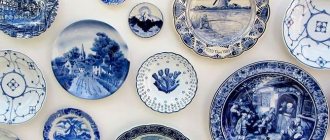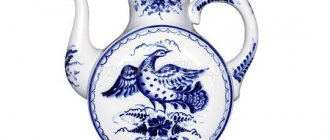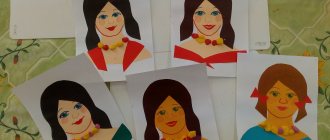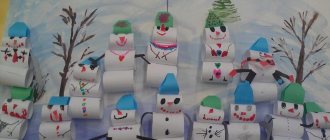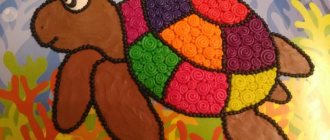The art of the people and their creativity invariably reflect their identity and spiritual wealth. One such widely known Russian folk craft is Gzhel. The unsurpassed art of filigree painting on clay products and the peculiarities of the design allow us to confidently call Gzhel the heritage of Russia. This folk craft with a long history is still very popular today. Gzhel not only pleases the eye with its unique and intricate ornamentation, but also immerses you in a mysterious and intriguing fairy-tale world.
History of Gzhel and its origins
The name of this folk craft is associated with the village of Gzhel, located in the Moscow region. This place is very picturesque, but not fertile. For a long time, the residents of this village tried to engage in agriculture. However, their time was wasted. All the failures were associated with a huge layer of white clay that lay almost on the surface. After it became known about the high quality of this clay and the fact that it makes excellent porcelain, a folk craft associated with the production of various pottery products was born. Local craftsmen created not only dishes, but also children's toys. The first pottery products of this area have been known since 1320.
Gradually, the original drawing, unique painting and amazing originality of Gzhel became very popular, and individual workshops merged into large productions.
There is an opinion that at first this folk craft was called “zhgel”, and then for ease of pronunciation they switched to the word “Gzhel”. The very name of the village meant “burn.”
How to distinguish a genuine product from a fake
Gzhel dishes are a sign of quality. She is highly regarded in Russia and abroad. But there is still a risk of encountering a fake. As a rule, their quality leaves much to be desired, and ordinary paint is used to apply the pattern.
You can recognize original products by the following features:
- The surface of a ceramic or porcelain product is absolutely smooth. The background is snow-white.
- On the bottom of the item there is a brand name - a swan, or “Gzhel” is written in clear and large letters. The word should be circled in an oval.
- Expensive goods are marked with an o and the name of the craftsman.
- Real Gzhel is durable because it is made from white clay with the addition of quartz sand.
- The image is drawn in detail.
- The products have a simple shape, without unnecessary pretentiousness.
Features of the Gzhel fishery
The difference between Gzhel and other folk crafts, which allows us to confidently call it a unique, distinctive, inimitable and original part of Russian artistic creativity, is the unusualness of the painting and, of course, handmade work. The main feature of Gzhel is a pattern in blue tones on a snow-white background and a pattern representing a complex floral pattern. Thanks to the contrast of cobalt paint and a white background, a unique brightness of color is created, which invariably attracts the eye and makes you admire the master’s work again and again.
In addition, the design is applied under the glaze and only then the product is fired. Cobalt is one of the few paints that can withstand oven temperatures of 1300 degrees.
GCD in the senior group “Acquaintance with the history of Gzhel painting. Painting a teapot"
Galina Mutina
GCD in the senior group “Acquaintance with the history of Gzhel painting. Painting a teapot"
Direct educational activities in the senior group.
Topic: “ Introduction to the history of Gzhel painting . Painting a teapot ."
Goal: To develop an aesthetic perception of folk crafts, to teach them to see their beauty; teach children to paint a teapot based on Gzhel painting .
— introduce Gzhel painting in blue tones;
— consolidate the ability to paint with watercolors, learn to paint with the end of a brush;
- teach the technique of blurring colors;
- cultivate interest in folk decorative art; evoke a positive emotional response to beauty.
Materials: presentation “Blue Fairy Tale”
, background music
“Gusli”
, visual material, products of
Gzhel masters , drawing sheets with the image of a teapot and the outline of Gzhel patterns , watercolors, brushes, cups of water, napkins.
Variety of Gzhel shapes
Gzhel products are distinguished not only by a huge variety of designs and original ornaments, but also by a wide selection of shapes.
The world of Gzhel is represented by such objects as:
• Tea pairs • Sets • Flower vases • Teapots • Sugar bowls • Jam sockets • Samovars • Souvenirs
A wonderful and unusual gift in addition to the above are: damask, plaque, kumgan.
Shtof is a tetrahedral-shaped vessel with a short neck and a stopper. In the old days it was used to store strong alcoholic beverages. The plaque, made using the Gzhel technique, is a painted decorative plate and serves as an excellent interior decoration. Kumgan is a vessel with a narrow neck, thin spout, handle and lid. Previously, it was used to wash hands and feet, and now, thanks to the masters of Gzhel, it is a wonderful and memorable gift.
Gzhel is also represented by a rich variety of souvenirs. Among them are figurines of animals, heroes of folk tales, snowmen, fish, nesting dolls, etc. Some of the products are dedicated to representatives of various professions, made in the form of the first leaf of a calendar, or have the shape of a bell.
Method of manufacturing Gzhel handicrafts
Creating products for Gzhel requires from the master extraordinary precision, painstakingness and an incredible flight of imagination. The dishes can be made of porcelain or majolica. The difference is that porcelain is white clay. It is more fragile and thin. Majolica is made from red clay and is more durable.
The entire manufacturing process can be divided into five stages. These include:
• Creation of a blank • Preparation for painting and first firing • Control and rejection of products • Painting • Second firing
The preparation process involves creating a porcelain or majolica mold from clay according to the artist’s sketches. This preparation is made on a pottery wheel, but not with your hands, but with special tongs. After the plaster mold is ready, liquid porcelain mass is poured into it, which gradually hardens. Gypsum absorbs moisture well, so porcelain hardens quickly.
An important feature of creating Gzhel is that all elements of the dishes, from handles to relief patterns, are made in different forms. This requires special care and attention from the master.
The next stage is preparation for painting. It includes polishing the product and firing it.
In order for the design to lie smoothly and neatly, each product is first cleaned with a special knife and polished. This process is carried out manually. Then the attachment points of various parts of the product are washed away, and the remaining irregularities are smoothed out using a foam roller. After this, the product is sent to the kiln for firing, which lasts about eight hours.
After firing, it is necessary to monitor the quality of the product and the presence of defects in it. They are identified using a fuchsin solution. This substance accumulates in the uneven surfaces of porcelain and turns bright red. Thus, unevenness or poor-quality joints in the product become visible. Next, imperfections are removed by roller sanding or washing. If the defect cannot be eliminated, the product is sent to scrap and melted down.
After this, painting begins. Each master has his own unique method of applying patterns and signs his work at the end. Then, the supporting parts of the product are treated with paraffin. To do this, the master manually dips the dishes into a bath of hot paraffin. Then, the product is dipped in glaze and sent for a second firing. It lasts quite a long time, eighteen hours. It is thanks to underglaze painting that the color saturation remains the same for a long time. Such products can be washed not only by hand, but also in the dishwasher.
Thus, each stage of the work is performed manually. Such work is very painstaking, therefore, mostly women work in Gzhel factories.
After firing, the product takes on its final form and is subject to subsequent packaging.
MAGAZINE Preschooler.RF
FCCM Topic: “Visiting Gzhel masters.”Goals: to introduce children to traditional Russian artistic craft - “Gzhel ceramics”; with the products of Gzhel masters, their form, purpose, characteristic features of painting of Gzhel porcelain - color, composition; cultivate respect for folk craftsmen and traditions in painting.
Materials: Gzhel dishes: teapot, samovar, vases, sugar bowl, oil dish, cups, plates; small sculpture: cat, horse, rooster; book by N. Suryanova “Blue Flowers of Gzhel”; illustrations depicting Gzhel objects; badges for each child with an image of a Gzhel rosette flower on a circle.
Progress of the lesson
Before class, the teacher hands out flower badges to everyone - an invitation to the exhibition. Exhibition of Gzhel dishes in the Russian Izba. Children name familiar objects and their purpose. The teacher clarifies the children's answers.
Teacher's story You came to an exhibition of products called “Gzhel” after the name of a small village near Moscow. Porcelain products are created in factories there. People fell in love with them, and the fame of the Gzhel masters spread throughout the country and even abroad.
There is such a place in the Moscow region - White Grove, Blue River. In this quiet Russian nature you can hear the echo of magical melodies. And the spring water brightens, And the breath of the wind is fresh. Gzhel cornflower, Forget-me-not Gzhel is blooming.
Everyone likes Gzhel for its blue color. The Gzhel people themselves say that their sky is blue, blue. So they decided to transfer this blue to white porcelain. All these products were made by Gzhel craftsmen. You look at every object and admire it. Admire it too. Gzhel masters are great masters. Some cups are slender and tall, others look like a barrel. And everyone’s hands are different. Look at this young lady - she’s a butter dish, and what a beautiful skirt she has, and her kokoshnik is like a rose. Products are made by sculptors, artists, craftsmen. First, the master makes a mold and pours the solution into them. (Show primary products in photos). Then, the products are fired in a kiln to make them durable. But the most interesting workshop is the picturesque one. Artists work here - people who paint objects after firing. (Show photos of the workshop's craftswomen). And now, on a white background, magical blue-blue patterns appear from under the artist’s hand. All products are coated with a special glaze, which is why they are so shiny. There is a border along the edge of all products. (Invite the children to look at the samovar and sugar bowl, name the decoration elements: stripes, dots, strokes, borders).
—What is the crockery decorated with? (Flowers, twigs, leaves, birds, figures of people). Blue grapes on blue rowan trees, Blue dawns and blue birds - Nothing compares with this beauty...
— What did you like most about the exhibition of products of Gzhel craftsmen? — Which patterns were the most unusual? (Children answer, reason). After the lesson, the group organizes an exhibition of products with Gzhel painting. Review them with your children. Offer to see if there are such products at home, and then tell them.
Drawing
Theme: "Winter blanket." Goals: continue to acquaint children with the products of Gzhel masters, with Gzhel painting; teach to see the beauty of dishes, fabric products, decorated with Gzhel painting; learn how to get different shades of blue by diluting blue paint with water; see the features of color and its shade; expand children's understanding of artistic crafts; cultivate love and respect for Russian culture.
Materials: Gzhel dishes; fabric products decorated with Gzhel painting: napkin, tablecloth, apron, mittens, shirt, sundress; Each child has a 10*10 square of white paper, divided into four parts diagonally, blue gouache, a palette, exercise paper, and a brush.
Progress of the lesson
In the quiet suburbs of Moscow the Gzhelochka River runs. The village stands along this river. Willow thickets run along the river, Craftsmen live in this village. They make painted dishes, They create miracles in blue and white.
The teacher offers to look at the exhibition at beautiful dishes, fabric products, decorated with Gzhel painting. — What products do you see? —What are they decorated with? (With patterns.) - What do these flowers look like? (For bells, daisies, roses, chrysanthemums.) - What color of paint do the masters use? (Blue, blue.) Colors swirl in ringing waves, To make the pansies sparkle. The pattern flows under the hand of the craftswoman, So that it cannot be repeated anywhere.
The teacher invites the children to make several shades of the same color. Shows how a palette can be used to create lighter shades by adding water. Children learn to produce different shades of blue. Then, the first triangle is painted with a color, the next ones with a shade, each lighter than the previous one. At the end of the lesson, the children, with the help of the teacher, connect all the squares and stick them on the base. The result is a large canvas, similar to a winter blanket.
Drawing
Topic: “Acquaintance with traditional Russian artistic craft - “Gzhel ceramics” and mastering simple elements of painting (straight lines of various thicknesses and shades, dots).”
Goals: continue to introduce children to the products of Gzhel masters; teach to see the beauty of small sculpture; create a pattern of straight lines of various sizes and dots; get a shade of blue (cyan) by mixing blue and white gouache; encourage you to see the beauty of these flowers; cultivate respect for the work of folk craftsmen. Material: Gzhel tableware: teapot, samovar, vase, sugar bowl, oil dish, cups, milk jug; small sculptures: cat, dog, rooster, tiger cub; illustrations depicting Gzhel objects and basic Gzhel patterns; Each child has a strip of paper 5*20 cm, gouache in blue and white, brushes of two sizes, white paper for mixing tones.
Progress of the lesson
The teacher invites children to an exhibition of products from Gzhel. Children look at the figures and dishes. The teacher draws attention to the fact that the figures look like toys - cheerful, funny, shiny and all decorated with paint of the same color - blue and its shade - blue; that the dishes are decorated with a border - a narrow blue thin stripe, with dots or small strokes located at the bottom.
The master took a brush in his hands and dipped it into the blue of heaven, Instead of canvas he took the whiteness of winter, Russian expanses... And patterns and monograms flowed, birds fluttered, gardens bloomed... Suddenly a blue drop rang, the miracle of Russian winter appeared to us, With the same ringing title of Gzhel. N. Savchenko
The teacher suggests getting blue by mixing blue and white gouache. Children mix two colors on a separate sheet of paper and make sure that with more white paint added to blue, the blue color becomes lighter. Next, the children complete the task - decorate a strip of white paper with a pattern: they learn to draw straight parallel lines of different thicknesses and shades, draw dots and circles. At the end of the lesson, the children, together with the teacher, examine all the work, applying stripes to the silhouettes of 2-3 objects.
Drawing
Topic: “Curbs. Drawing the border."
Goals: continue to introduce children to folk crafts; learn to look at a pattern, highlight its elements - dots, wavy and arcuate lines, loops; learn to draw borders on a narrow strip of paper; encourage you to see the beauty of blue and white colors; develop aesthetic feelings. Materials: Gzhel tableware with options for border decoration, small sculpture, white paper 10*20, divided lengthwise into two parts, blue gouache, thin brush.
Progress of the lesson
The teacher invites children to an exhibition of Gzhel dishes:
Blue and white dishes, Tell me, where are you from? Apparently, she came from afar and blossomed like flowers?
Children consider options for decorating the dishes, and with the help of the teacher, identify the main elements of the pattern: the teacher shows the border that decorates all the dishes - this is either a thin straight stripe, or a wavy or arched blue line, at the bottom of which there are dots or small strokes. Then, the teacher invites the children to complete exercises to familiarize themselves with the basic elements of borders. Shows children how to hold the brush when doing work (with three fingers, perpendicular to the sheet), explains that lines should be drawn with the tip of the brush. At the end of the lesson, the teacher organizes an exhibition of works and praises all the children. Children choose the works they like best.
Application
Topic: “Gzhel flower”.
Goals: continue to introduce children to folk crafts; teach to see the beauty of dishes, fabric products, decorated with Gzhel painting; learn to cut a circle by smoothly rounding the corners of a square, cut the circle in half along the fold; compose from parts - circles, semicircles and a narrow strip - images of unblown and blossomed flowers; use two shades of blue in the applique; reinforce neat gluing techniques. Materials: exhibition of products of Gzhel craftsmen; illustration depicting a flower and buds; flannelgraph and flower parts; two semicircles of a dark shade (petals) for a blossoming flower and two circles of different sizes for a bud, several blue and light blue semicircles (leaves), a strip (stem), glued on the back side with flannel; square to show cutting techniques. Some children have squares 5*5 cm and 4*4 cm of the same color, but different shades, others have squares 5*5 cm and 2.5*2.5 cm for buds; for two children narrow strips 13*0.5 cm (stems); scissors, glue, rectangular sheets of white paper for gluing the applique.
Progress of the lesson
The teacher says that in spring many different flowers bloom in meadows, flower beds, gardens and parks. Shows an illustration of blooming flowers and buds. He explains that all the petals of a blossoming flower are visible, but the petals of a bud are still curled up and those inside are not visible. He says that today children will learn to depict a blossoming flower and bud. But these flowers will not be ordinary, but fabulous - Gzhel. Places a flannelgraph in front of them, on which two blue stems (straight strips) were pre-attached. He says that a bud can be depicted from two circles - a large and a small one. Its petals are curled (he places a large circle on the stem), and those inside the bud are just beginning to show (he places a small circle so that it is halfway over the large one). He asks the children what color the large and small circles are from which the bud is made (blue, but in different shades, the large one is lighter, and the small one is darker). Next, the teacher asks: “What is missing from our unblown flower?” The children answer. The teacher continues: “Leaves can be made from semicircles.” Calls the child and invites him to attach the leaves to the stem. Then the teacher lays out a blooming flower. First the upper petals, which are slightly apart, then the lower ones. Draws children's attention to the fact that the leaves can be attached to the stem differently than those of the first flower - with the convex side down. Invites children to choose who will represent a bud and who will represent a blossoming flower. Explains and shows how to cut a circle out of a square (you should start from the middle of the side of the square and round the corner to the middle of the other side so that it falls off; all four corners should fall off, then the circle will be the desired size). Children can place a square in front of them and use their finger to indicate where they will cut with scissors to create a circle. The teacher asks the children where to start working. Will everyone have to cut the circle in half for the flower head? The children answer. During the work, the teacher ensures that the children, when cutting out circles, use the entire surface of the squares, and with their left hand smoothly turn the square towards the scissor blades; advises starting with the flower head, and then gluing the stem. At the end of the lesson, all works are laid out on a stand close to each other. It turns out to be a beautiful Gzhel panel made from appliqués.
Modeling
Topic: “Introduction to the art of pottery. Modeling dishes (cup with handle).”
Goals: to introduce children to the art of pottery; develop interest in the work of a potter, folk traditions, and customs; continue to teach how to look at the products of Gzhel masters, recognize familiar objects; introduce the material for modeling - clay; learn to sculpt a cup from clay by pressing, rolling and smearing; instill love and respect for the work of folk craftsmen.
Materials: illustrations depicting a pottery workshop, dishes: plates, cups, dish, teapot, decorated with Gzhel painting, clay, wet wipes and sponge.
Progress of the lesson
The board contains illustrations depicting a pottery workshop; on the table there is an exhibition of ceramic dishes decorated with paintings. Educator. In ancient times, clay dishes were first sculpted by hand, and then a potter's wheel was invented, which made it possible to sculpt dishes faster. Then, the craftsmen fired the molded dishes and decorated them with a pattern that they came up with themselves. The wavy line represents water, straight lines represent earth, dots represent seeds, and oblique lines represent rain. Next, the teacher invites the children to look at the exhibition of ceramic dishes. Educator. — What is on our exhibition? (Dishes.) - What is it like? (Brilliant, beautiful.) - What is this dish needed for? (Purpose of dishes.)
Believe me or not, But the most beautiful of all is the Gzhel painting. Cups, teapots and dishes - All the dishes are just a miracle!
The teacher suggests making a cup using the pressing method, clarifies the method of attaching the handle to the cup - smearing, and reminds that when working with clay it is necessary to constantly moisturize your hands with a cloth. The teacher provides the necessary assistance during the lesson, suggests how to better convey the shape of the product, make the cup more stable, and smooth out unevenness with a damp sponge. At the end of the lesson, children put their crafts on the table and examine them, comparing them with dishes made by Gzhel craftsmen. The teacher praises the children and draws attention to the beauty of the shape of the cups made by the children.
| Next > |
Features of Gzhel painting
The uniqueness, grace and incredible beauty of Gzhel products are given by the peculiarities of their painting. These include:
• Snow-white background • Deep blue pattern • Surface glazing • Diverse and complex floral patterns • Handmade
The use of only two colors and the uniqueness of the images make it possible to create unique masterpieces of folk art, therefore, there are no two identical products from Gzhel.
The pattern of the future product is first carefully thought out, and only after that is applied to the porcelain surface. Ancient masters applied the drawing immediately, without a preliminary sketch. They drew their inspiration from nature or from pictures of folk life. Painting is done with a solution of cobalt oxide, which after firing acquires a deep blue color. It is applied with special squirrel brushes.
There is another type of painting in the Gzhel style, which is called majolica. Its peculiarity is that not one color, but five, is applied to the snow-white surface.
Many centuries ago, Gzhel masters tried to reflect in their art their vision of the world around them, pictures of urban and rural life, inexplicable natural phenomena, their thoughts and fantasies. Based on this, the general style of painting can be divided into three main groups:
• Ornamental • Floral • Subject
The ornamental pattern is original, unusual and a certain association can be traced in it. The most common ornamental patterns are: drops, tendrils, blades of grass, pearls, combs. In addition, a checkered pattern is traditionally applied along the side and border, which is a chain of blue squares.
The plant pattern is considered classic for Gzhel. It is usually quite stylized, but you can always distinguish one plant from another. Most often, craftsmen depict berries, blades of grass, cuttings, and flowers on Gzhel products. Garlands of berries on porcelain can easily be intertwined with ears of wheat or a riot of floral patterns. At the same time, gooseberries can be easily distinguished from currants.
Often ornamental painting is combined with a floral pattern.
The plot drawing was one of the first to appear. It presented pictures from the life that surrounded the master. It could be beautiful landscapes, fun fairs, sleigh rides, colorful natural phenomena.
Characteristic features of the painting
There is an opinion that Russian art is not distinguished by lightness and laconicism. Do you think so too? Then you know nothing about Gzhel. Nowadays, it’s not just unique ornaments and designs, but a full-fledged stylistic direction. It is used both for the manufacture of ceramic products and for interior decoration or clothing.
Distinctive features of the fishery:
- The surface is glazed.
- Snow-white background.
- The ornament is made exclusively in blue or light blue shades.
- Complex floral pattern in Russian folk style.
- Only handmade.
Ornate painting in cobalt blue colors on a snow-white background is what distinguishes Gzhel from other folk crafts. And handmade production elevates the products into the category of ceramic masterpieces.
It is believed that it is impossible to find the same ornament or design, because each craftsman adds a touch of individuality to the product.
Primary colors
A distinctive feature of the fishery is manual work. The artist puts a piece of his own soul into each pattern. Several basic shades are used in painting:
- Snow-white (for bone china).
- Colored majolica.
- Dull cobalt.
- Bright blue, ranging from sky blue to dark blue.
| The process of the appearance of the rich shade of Gzhel deserves special attention. During operation, it is monochrome; blue and cobalt appear only after firing at high temperatures. |
The classic color of Gzhel is a cobalt shade on a white background. The finished product is dipped into a snow-white glaze, then placed in an oven (temperature 1400 degrees). As a result, the coating becomes transparent and the ornament acquires a rich color. The product itself acquires hardness and a glossy shine.
The coating can be coated with gold or decorative elements made of platinum. Then the firing is repeated. There are several color groups in Gzhel painting:
- Overglaze colored. Complemented with a pattern of gold or platinum. Used to decorate holiday tableware and souvenirs. The manufacturing process is labor-intensive and requires high skill from the artist.
- Dull background cobalt. An amazing combination of sophistication and solemnity. The background is a dark blue glaze. For painting, use snow-white paint, which gives a mirror image to the ornament. As a result, plants and animals turn from blue to white, the pattern resembles the snow patterns that frost puts on windows.
- Bone white china. Products in a snow-white shade without additional decor. Some products contain a thin strip of gold or platinum. It is allowed to apply small ornaments and inscriptions to the surface using colored paint.
Return to contents
Elements and patterns of Gzhel painting
The theme of the drawing is the painter’s vision of the surrounding world and the result of centuries-old creativity, which has absorbed folk traditions. When designing products, artists often use elements of icon painting, scenes from life, and natural phenomena.
Modern themes of Gzhel patterns are divided into four categories:
- Subject drawing, including images of landscapes and seasons.
- Ornament. Classic mustaches, checkers, and combs for fishing.
- Floral pattern.
- Animals. Most often, artists depict birds.
Modern masters of Gzhel
Thanks to the creative heritage left by the ancient masters of Gzhel, their modern followers were able not only to revive this great folk craft, but also to introduce into it notes of modern art, features of life and the originality of the views of the present time. At the end of the 19th century, modern Gzhel began to gain popularity, however, they painted mostly simple figures and the design was not as intricate as that of the ancient masters. Gradually, porcelain sculpture and decorative vases began to be mastered, and new original types were added to the traditional Gzhel pattern.
Thus, thanks to modern masters, there was a revival of Gzhel, it acquired new interesting techniques, exciting plots and a special style. Now these products are widely in demand all over the world and are an integral part of Russian folk art.
Gzhel was and remains an unsurpassed symbol of the enormous creative imagination and highest skill of the Russian people. This craft is a kind of history book, which carefully preserves the imprint of the time in which it was created, immerses us in a world full of incredible miracles and unique colors, and tells about how our ancestors lived. However, the popularity of Gzhel lies in the fact that it is capable of displaying pictures of modern times, helping people to look at themselves from the outside, to see how beautiful and amazing the world around them is.
